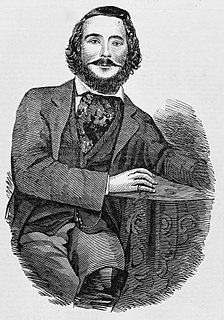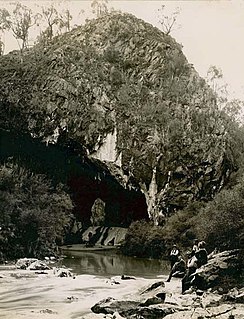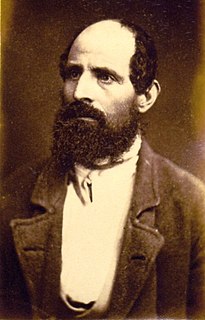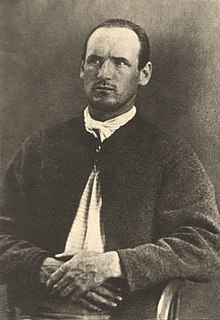
Bushrangers were originally escaped convicts in the early years of the British settlement of Australia who used the bush as a refuge to hide from the authorities. By the 1820s, the term had evolved to refer to those who took up "robbery under arms" as a way of life, using the bush as their base.

General Sir Ralph Darling, GCH was a British Army officer who served as Governor of New South Wales from 1825 to 1831. He is popularly described as a tyrant, accused of torturing prisoners and banning theatrical entertainment. Local geographical features named after him include the Darling River and Darling Harbour in Sydney.

Frank Gardiner was an Australian bushranger.

Brothers Thomas and John Clarke were Australian bushrangers from the Braidwood district of New South Wales. They committed a series of high-profile crimes which led to the enacting of the Felons' Apprehension Act (1866), a law that introduced the concept of outlawry in the colony and authorised citizens to kill bushrangers on sight. Thomas was proclaimed an outlaw on 31 May 1866.
Jack the Rammer, alias of William Roberts, was a bushranger in the Monaro District near Cooma in New South Wales during the mid-1830s.

The Abercrombie Caves, contained within the Abercrombie Karst Conservation Reserve, are a series of limestone arch caves that are located in the Central West region of New South Wales, Australia. The caves are renowned for their karst qualities, namely the formation that has been eroded by water action that has developed from a sinkhole to become a blind valley. Several good examples of crayback formations exist in both entrances.

John Donahue, also spelled Donohoe, and known as Jack Donahue and Bold Jack Donahue, was an Irish-born bushranger in Australia between 1825 and 1830. He became part of the notorious "Wild Colonial Boys".
The following lists events that happened during 1830 in Australia.
Edward Davis (1816–1841) was an Australia convict turned bushranger. His real name is not certain, but in April 1832 he was convicted under the name George Wilkinson for attempting to steal a wooden till and copper coins to the total value of 7 shillings. Sentenced to seven years transportation, he arrived in Sydney on the Camden in 1833 and was placed in the Hyde Park Barracks. Over the next few years he escaped four times: on 23 December 1833 from the Barracks, on 1 December 1835 from Penrith, on 10 January 1837 from the farmer he had been assigned to, and for a final time on 21 July 1838.
The bushranger ban was a ban on films about bushrangers that came in effect in Australia in 1911–12. Films about bushrangers had been the most popular genre of local films ever since The Story of the Kelly Gang (1906). Governments were worried about the influence this would have on the population and bans against films depicting bushrangers were introduced in South Australia (1911), New South Wales and Victoria (1912).

John Vane, known informally as 'Jack' or 'Johnny' Vane, was an Australian bushranger who joined with the John Gilbert's gang for a short period during 1863. He rode with Gilbert, Ben Hall, John O’Meally and his friend Mick Burke, all of whom eventually met violent deaths. Burke, who had been Vane's childhood friend, died in a violent gun-fight at 'Dunn's Plains', near Rockley. Vane managed to avoid the fate of his companions when he gave himself up. In 1905 Vane collaborated with author and newspaper editor, Charles White, in recording his recollections of the period he spent as part of the bushranging gangs led by Gilbert, Hall and O’Meally. Vane’s biography, edited by White, was published in 1908.

Charles White (1845–1922) was an Australian journalist, author and historian, notable for his books on bushranging and other aspects of Australian history.

John O'Meally, known informally as 'Jack' O'Meally, was an Australia bushranger. He was recruited to join the Gardiner–Hall gang to carry out the gold escort robbery near Eugowra in June 1862, Australia's largest gold theft. O'Meally became a member of the group of bushrangers led by Johnny Gilbert and Ben Hall, which committed many robberies in the central west of New South Wales. Considered to be the most violent and hot-headed of the group, O'Meally was probably responsible for two murders during this time. The gang managed to evade the police for long periods and became the most notorious of the bushranging gangs of the 1860s. Jack O'Meally was shot and killed during an attack on the 'Goimbla' station homestead in November 1863.

Thomas Frederick Lowry, better known as Fred Lowry, was an Australian bushranger.
Ralph Entwistle was an English labourer who was transported to the British penal colony of New South Wales as a convict in 1827. As a member of the Ribbon Gang, his escape sparked the Bathurst Rebellion of 1830. He, along with nine of his gang members, were captured by police and executed in 1830.

John Foley was a bushranger and associate of Fred Lowry. In July 1863 they robbed several mail coaches, including the Mudgee mail robbery which netted £5,700 in bank-notes. Foley was captured several weeks later with bank-notes from the Mudgee mail in his possession. He was tried at Bathurst and sentenced to fifteen-years hard labour. Foley was released in 1873; he settled in the Black Springs district near Oberon and led a respectable life until his death in 1891.

Lawrence Cummins, known informally as Larry Cummins, was a bushranger who operated primarily in the districts surrounding the Abercrombie River. In July 1863 he participated in the Mudgee mail robbery led by Fred Lowry and John Foley. Soon afterwards Cummins and his younger brother John carried out several robberies. They were identified and John Cummins was apprehended; he was accidentally shot and killed while being escorted by police constables. Three weeks later Cummins was captured with his associate Lowry, in an encounter with the police which resulted in Lowry’s death. Cummins was sent to Berrima Gaol in late 1863, from where he escaped in November 1866 with another prisoner. From December 1866 to April 1867 Cummins carried out a series of audacious robberies. In April, during an attempted robbery of Webb's store on the Fish River in company with John Foran, he received a wound in the face from birdshot. He was captured soon afterwards and sentenced to thirty years hard labour and sent back to Berrima Gaol.

Bluecap was an Australian bushranger. Born and raised in New South Wales, he began bushranging in 1867, leading a gang responsible for robberies throughout the Riverina region. He suffered from ophthalmia, and earned his alias on account of a piece of cloth he wore to protect his eyes from sunlight. Captured in November 1867, Bluecap was tried and convicted of armed robbery. He was imprisoned in Parramatta Gaol and released in 1874.
John Peisley, known informally as Jack Peisley, was an Australian bushranger who is believed to be the first bushranger born in Australia. He was a skilled bushman and horse-rider. While serving time at Cockatoo Island in the late 1850s for horse-stealing, Peisley became acquainted with Frank Gardiner. Peisley was granted a ticket-of-leave in December 1860 and soon afterwards commenced armed robberies in the Goulburn, Abercrombie, Cowra and Lambing Flat districts. He was highly mobile, riding well-bred horses and operating in districts familiar to him. Peisley’s criminal accomplices were often unnamed in newspaper reports, though Gardiner was a known associate. In December 1861 Peisley was involved in a drunken altercation, culminating in the shooting of William Benyon, who died from his wound. After his capture in January 1862 he was tried for Benyon’s murder and hanged at Bathurst in April 1862. Peisley achieved considerable notoriety within a short period and his activities and methods foreshadowed the spate of bushranging in the following years.














